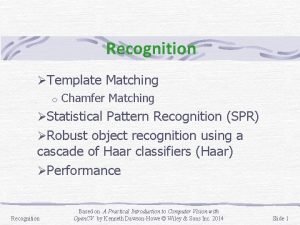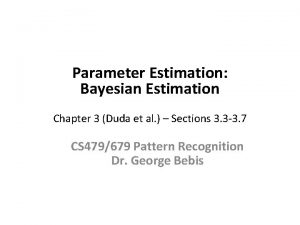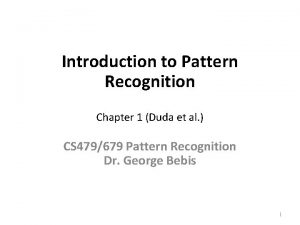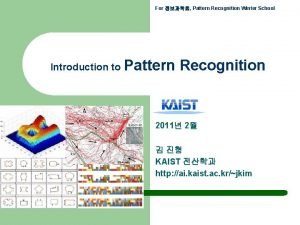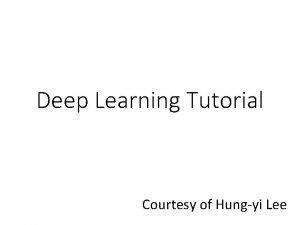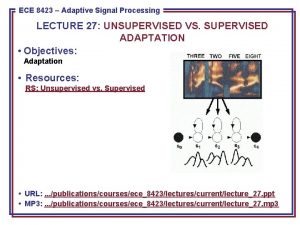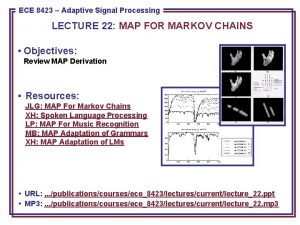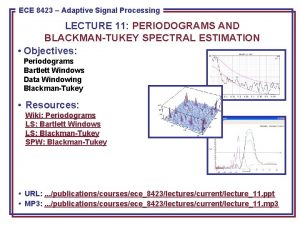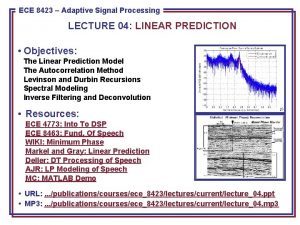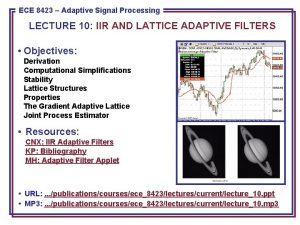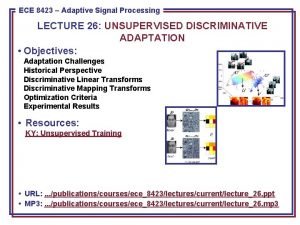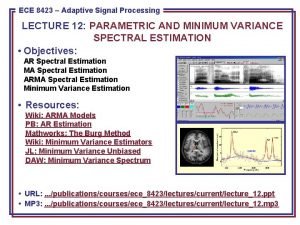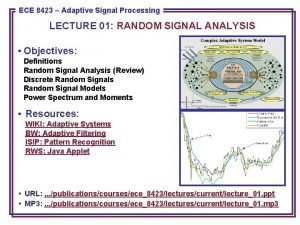ECE 8423 8443Adaptive Pattern Recognition ECE Signal Processing










- Slides: 10

ECE 8423 8443––Adaptive Pattern Recognition ECE Signal Processing LECTURE 28: STATE OF THE ART • Objectives: Language Modeling in ASR Discriminative Feature Mapping Example System Course Evaluations • Resources: MB: Unsupervised LM Adaptation RS: Statistical Language Modeling DP: Discriminatively Trained Features AS: Discriminative Adaptation IBM: GALE Mandarin • URL: . . . /publications/courses/ece_8423/lectures/current/lecture_28. ppt • MP 3: . . . /publications/courses/ece_8423/lectures/current/lecture_28. mp 3

Statistical Approach To Speech Recognition ECE 8423: Lecture 28, Slide 1

Speech Recognition Architectures Core components: • transduction • feature extraction • acoustic modeling (hidden Markov models) • language modeling (statistical Ngrams) • search (Viterbi beam) • knowledge sources Our focus will be on the acoustic modeling components of the system. ECE 8423: Lecture 28, Slide 2

Statistical Language Modeling: N-Gram Models • The probability of a word sequence, , can be decomposed as: • Clearly, estimating this for every unique word history is prohibitive. A practical approach is to assume this probability depends only on an equivalence class: • There are three common simplifications, known as N-grams, we can make: • Of course, there are many ways to merge histories, such as based on linguistic context (e. g. , parts of speech such as article, noun), and we can use higher-order N-grams. ECE 8423: Lecture 28, Slide 3

N-Gram Models Require Adaptation ECE 8423: Lecture 28, Slide 4

MAP Language Model (LM) Adaptation • The LM adaptation problem is often described as an interpolation problem between an existing LM and an LM estimated from new data. • Any of the approaches we have previously discussed can be employed. MAP adaptation can be shown to simplify to: • If additional assumptions about the priors for the histories are made, this simplifies further to: • Most of the adaptation methods we have discussed previously can be applied to this problem because a language model at its core is just a likelihood model. • However, language models must also deal with the problem of unseen events, and hence models must be smoothed to account for sparseness of data. ECE 8423: Lecture 28, Slide 5

Discriminatively-Trained Features • Features can also be adapted using a similar transformational approach that we used for Gaussian means: where ht represents a transformation high-dimensional features and M represents a dimensionality reduction transformation. This approach combines the large-margin classification approaches (e. g. , support vector machines) with traditional GMM approaches. • The transformation M is typically estimated using an MPE criterion, and hence this method is often called f. MPE. ECE 8423: Lecture 28, Slide 6

State of the Art Systems (IBM GALE) ECE 8423: Lecture 28, Slide 7

State of the Art Systems (IBM GALE) ECE 8423: Lecture 28, Slide 8

Summary • Discussed adaptation of language models and showed the process is similar to that for feature vectors. • Discussed feature-space adaptation. • Reviewed a state of the art system that uses many forms of adaptation. • Course evaluations… ECE 8423: Lecture 28, Slide 9
 Patterns and pattern classes in digital image processing
Patterns and pattern classes in digital image processing Four part processing model for word recognition
Four part processing model for word recognition Four part processing model for word recognition
Four part processing model for word recognition Chamfer matching
Chamfer matching Bayesian parameter estimation in pattern recognition
Bayesian parameter estimation in pattern recognition Introduction to pattern recognition
Introduction to pattern recognition Pattern recognition
Pattern recognition Design cycle of pattern recognition
Design cycle of pattern recognition Pattern recognition
Pattern recognition Pattern recognition lab
Pattern recognition lab Pattern recognition clinical reasoning
Pattern recognition clinical reasoning



